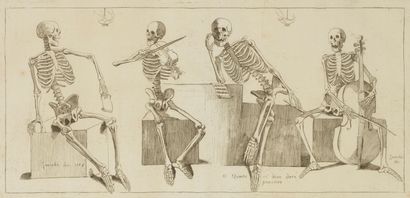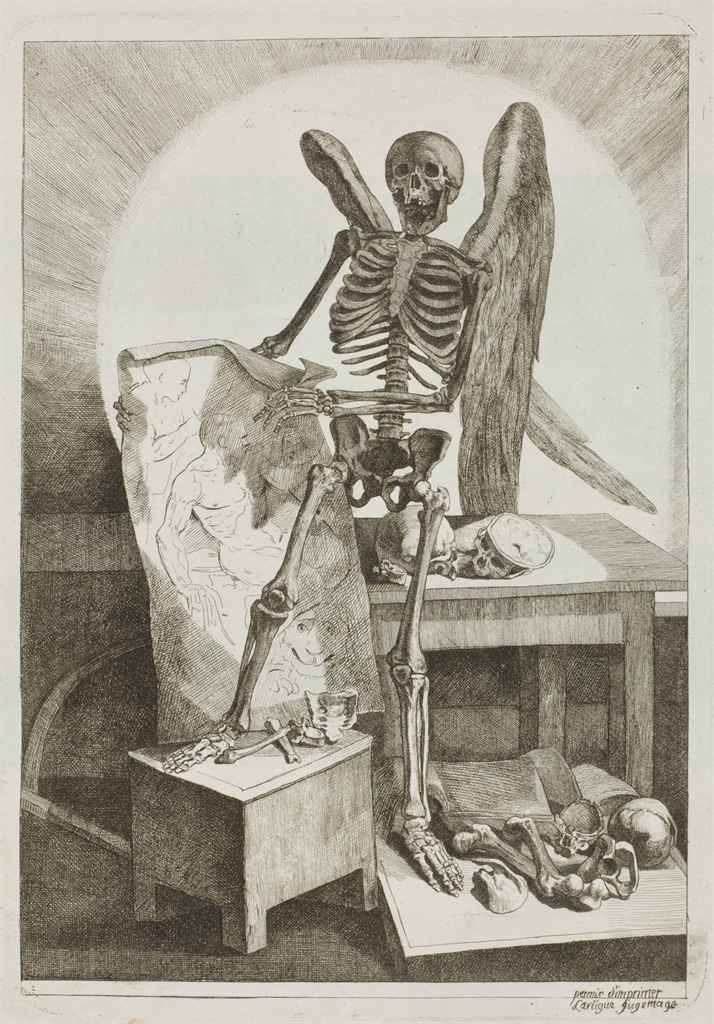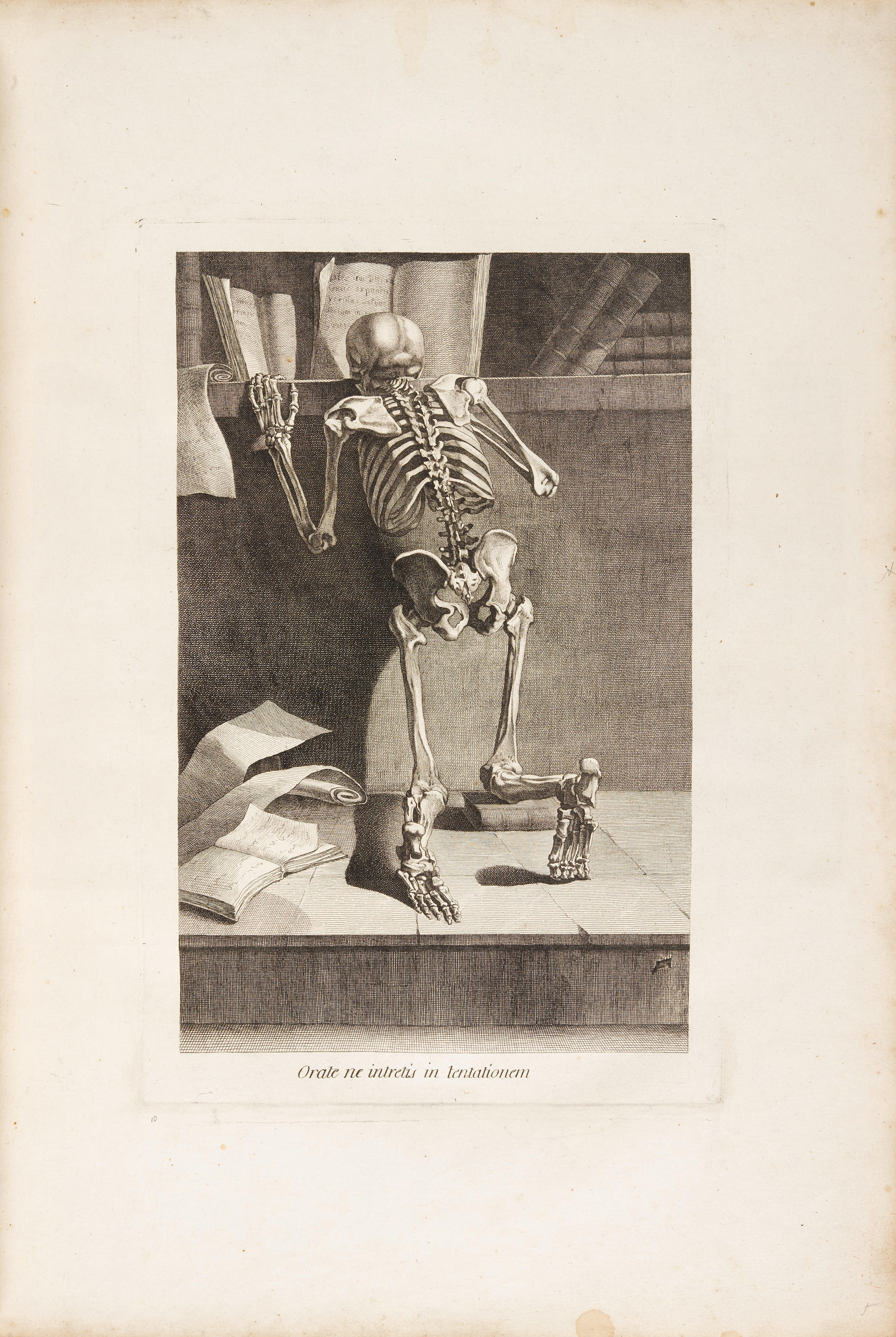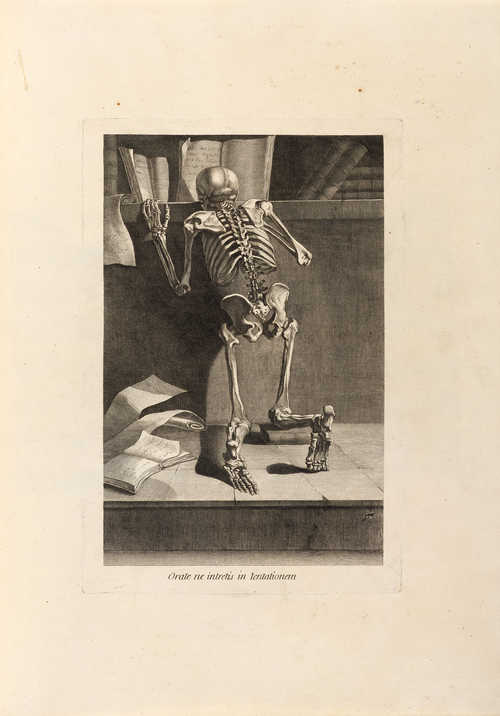GAMELIN, Jacques (1738-1803). Nouveau recueil d'ostologie et de myologie, dessin d'aprs nature ... pour l'utilit des sciences et des arts. Toulouse: J.F. Desclassan, 1779.
GAMELIN, Jacques (1738-1803). Nouveau recueil d'ostologie et de myologie, dessin d'aprs nature ... pour l'utilit des sciences et des arts. Toulouse: J.F. Desclassan, 1779. 2 parts in one, broadsheets (545 x 417 mm). 38 leaves, including title-pages for each part and privilege leaf at end. 2 etched frontispieces, 2 etched title-vignettes, etched portrait of Baron de Puymaurin with a dedication by Gamelin below, 9 large etched vignettes in text, 82 engraved plates, including 11 preceded by outline plates keyed to the text (approximately 12 plates stained or damaged, one overslip torn, a few plates from second part bound with the first part). Contemporary marbled sheep gilt (some wear at corners). Provenance : M. Copasson? (stamp erased from title and portrait); Haskell F. Norman (bookplate; his sale part II, Christie's New York, 15 June 1998, lot 463). FIRST EDITION. According to his own statement within the text Gamelin, who is characterized by Benezit as one of the best artists of the Midi, published this atlas of the bones and muscles for artists in an edition of only 200 copies, engraved from drawings that Gamelin made at his own dissection facility with the assistance of professors of the College of Surgery of Toulouse. The first part of the work is devoted to the bones and the second part, with etchings in the crayon manner, concerns the muscles. Gamelin personally engraved some of the plates; others are by Martin and Lavalée. They are distinct from the plates of other works of its type, being larger, more artistically varied, and more expressive and fantastic in their conceptions. Allegorical scenes of death and battle and genre scenes appear throughout the book. Gamelin's plates show a constant interplay between the artistic and the anatomic: emblematic images in the seventeenth-century tradition, vignettes in the coquettish eighteenth-century manner, and classic studies of figures in repose and movement vie with straightforward "medical" depictions of bones and muscles. "Gamelin, in the preface to the second book, is critical of what he considered the typically unvaried nature of the figures in anatomical illustrations (folio 72v). His figures are distinguished by their bold and dramatic nature poses, such as the écorché crucifixion of the second book or this remarkable praying skeleton from the first. It is followed by a skeleton sitting up from his tomb in response to the trumpet blast on the Day of Judgment (folio II). Gamelin's plate of Death as a winged skeleton in an aureole of light, holding a sketch of nudes (folio 4), represents the study of anatomy by artists with its unavoidable allegorical overtones. The praying skeleton of folio 10 kneels before a shelf of books, one of which is open to the 'Dies Irae.' This skeleton, viewed from the back, with the bones of the left leg bodly foreshortened, contrasts with that of the preceding plate, a skeleton in anterior view without any indication of a background" (Cazort, Kornell, Roberts, The Ingenious Machine of Nature: Four Centuries of Art and Anatomy [1996] pp. pp. 215-217). Gamelin is best known for his paintings and battle scenes which can be found throughout museums in France. His technical perfection, coupled with the emotional and fantastic elements in his images, have led him to be seen as a precursor of Goya. It is possible that the young Goya may have known or studied with Gamelin, who taught in Rome during the time Goya was there. VERY RARE. Choulant-Frank p.352; Campbell Dodgson, "The Macabre in Two Centuries," in: Print Collector 's Quarterly (April, 1929) XVI, pp. 135-43; Duval & Cuyer, l'Histoire de l'Anatomie Plastique (1898) pp. 222-33 (may be the first to draw the parallel between Gamelin and Goya); Garrison-Morton 401.1; Mouton, J. Gamelin (1948) pp. 216-250; NLM/Blake 165; Norman 872; Sappol, Dream Anatomy pp. 55 and 137-139; Waller 3404; Wolf-Heidegger & Cetto, Die anatomische Sektion in bildlicher Darstellung (1967) pp. 229-230.
GAMELIN, Jacques (1738-1803). Nouveau recueil d'ostologie et de myologie, dessin d'aprs nature ... pour l'utilit des sciences et des arts. Toulouse: J.F. Desclassan, 1779.
GAMELIN, Jacques (1738-1803). Nouveau recueil d'ostologie et de myologie, dessin d'aprs nature ... pour l'utilit des sciences et des arts. Toulouse: J.F. Desclassan, 1779. 2 parts in one, broadsheets (545 x 417 mm). 38 leaves, including title-pages for each part and privilege leaf at end. 2 etched frontispieces, 2 etched title-vignettes, etched portrait of Baron de Puymaurin with a dedication by Gamelin below, 9 large etched vignettes in text, 82 engraved plates, including 11 preceded by outline plates keyed to the text (approximately 12 plates stained or damaged, one overslip torn, a few plates from second part bound with the first part). Contemporary marbled sheep gilt (some wear at corners). Provenance : M. Copasson? (stamp erased from title and portrait); Haskell F. Norman (bookplate; his sale part II, Christie's New York, 15 June 1998, lot 463). FIRST EDITION. According to his own statement within the text Gamelin, who is characterized by Benezit as one of the best artists of the Midi, published this atlas of the bones and muscles for artists in an edition of only 200 copies, engraved from drawings that Gamelin made at his own dissection facility with the assistance of professors of the College of Surgery of Toulouse. The first part of the work is devoted to the bones and the second part, with etchings in the crayon manner, concerns the muscles. Gamelin personally engraved some of the plates; others are by Martin and Lavalée. They are distinct from the plates of other works of its type, being larger, more artistically varied, and more expressive and fantastic in their conceptions. Allegorical scenes of death and battle and genre scenes appear throughout the book. Gamelin's plates show a constant interplay between the artistic and the anatomic: emblematic images in the seventeenth-century tradition, vignettes in the coquettish eighteenth-century manner, and classic studies of figures in repose and movement vie with straightforward "medical" depictions of bones and muscles. "Gamelin, in the preface to the second book, is critical of what he considered the typically unvaried nature of the figures in anatomical illustrations (folio 72v). His figures are distinguished by their bold and dramatic nature poses, such as the écorché crucifixion of the second book or this remarkable praying skeleton from the first. It is followed by a skeleton sitting up from his tomb in response to the trumpet blast on the Day of Judgment (folio II). Gamelin's plate of Death as a winged skeleton in an aureole of light, holding a sketch of nudes (folio 4), represents the study of anatomy by artists with its unavoidable allegorical overtones. The praying skeleton of folio 10 kneels before a shelf of books, one of which is open to the 'Dies Irae.' This skeleton, viewed from the back, with the bones of the left leg bodly foreshortened, contrasts with that of the preceding plate, a skeleton in anterior view without any indication of a background" (Cazort, Kornell, Roberts, The Ingenious Machine of Nature: Four Centuries of Art and Anatomy [1996] pp. pp. 215-217). Gamelin is best known for his paintings and battle scenes which can be found throughout museums in France. His technical perfection, coupled with the emotional and fantastic elements in his images, have led him to be seen as a precursor of Goya. It is possible that the young Goya may have known or studied with Gamelin, who taught in Rome during the time Goya was there. VERY RARE. Choulant-Frank p.352; Campbell Dodgson, "The Macabre in Two Centuries," in: Print Collector 's Quarterly (April, 1929) XVI, pp. 135-43; Duval & Cuyer, l'Histoire de l'Anatomie Plastique (1898) pp. 222-33 (may be the first to draw the parallel between Gamelin and Goya); Garrison-Morton 401.1; Mouton, J. Gamelin (1948) pp. 216-250; NLM/Blake 165; Norman 872; Sappol, Dream Anatomy pp. 55 and 137-139; Waller 3404; Wolf-Heidegger & Cetto, Die anatomische Sektion in bildlicher Darstellung (1967) pp. 229-230.










Try LotSearch and its premium features for 7 days - without any costs!
Be notified automatically about new items in upcoming auctions.
Create an alert